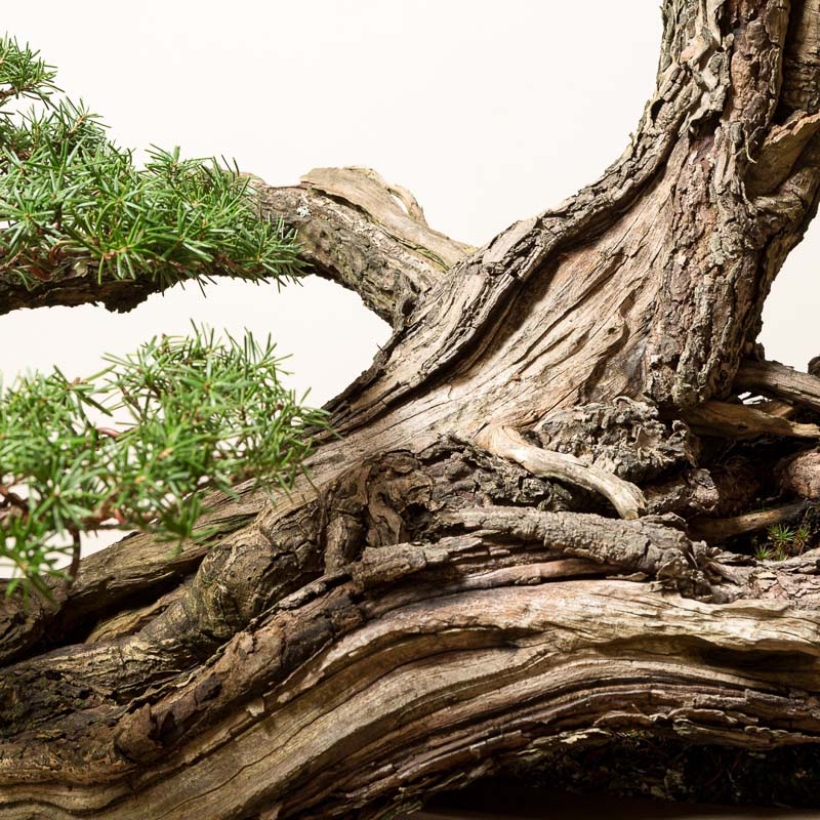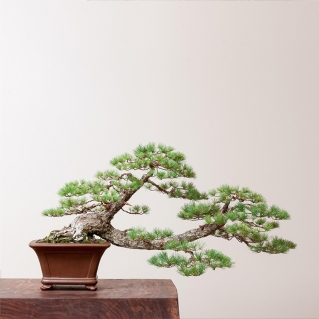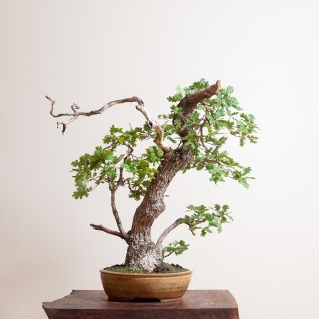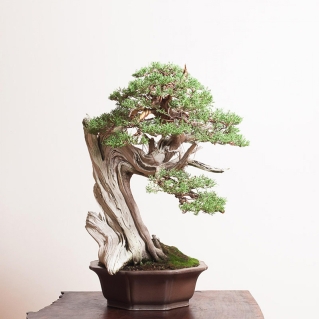Hemlock Bonsai
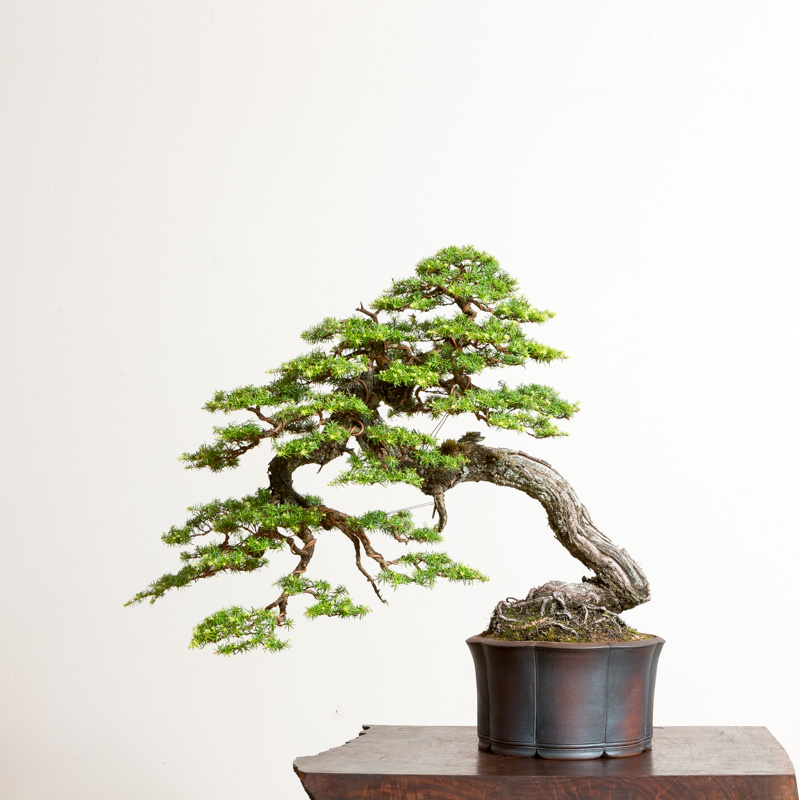
General Information
Hemlock—Tsuga—is a species of evergreen found in forests in North America, and from the Himalayas to China, Taiwan and Japan.
Hemlocks are tall, graceful trees with spreading branches that droop down at their tips to create a cascading effect. Their cinnamon red bark becomes deeply furrowed as the tree ages. An evergreen conifer, hemlock’s cones are small and pale brown, and their flattened, linear leaves are graced by silvery-white bands underneath.
Hemlock’s compact nature, aggressiveness, durability, and tolerance make it the perfect tree for the Bonsai model.
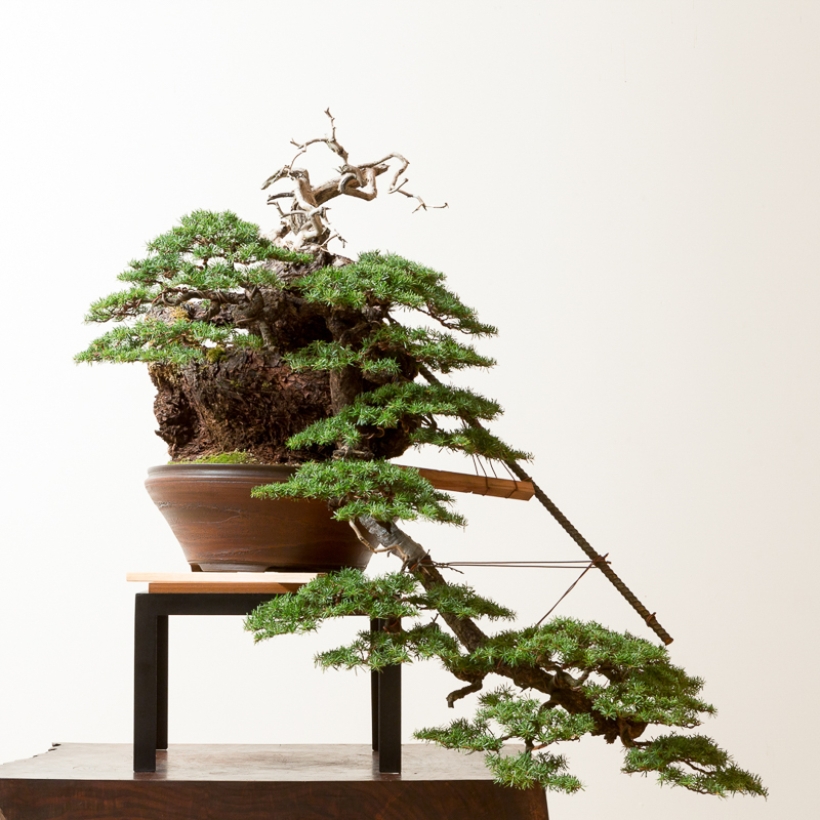
Caring for Hemlock Bonsai
Watering
Hemlock bonsai is a high water-mobility, high water-consumptive tree.
To maintain the proper balance of water and oxygen, the soil must stay on the moist-to-damp side.
Always water your hemlock bonsai when the soil is slightly damp, as allowing it to dry out could be catastrophic.
Sun Exposure
Hemlock bonsai prefer full sun in the spring and fall.
This requirement limits the tree’s capacity to be a bonsai to the northern portions of North America, Europe, Asia, or the very southern portions of the Southern Hemisphere.
Hemlock bonsai need cool nights and a significant dormant period in the winter since they are not a true alpine species.
If you are cultivating hemlock bonsai in a northern state of North America or Europe, you’ll need to provide protection from the afternoon sun during the spring and fall months. It’s best to give your tree morning sun and afternoon shade, or put it under a 30% shade cloth through the intense portions of the summer.
Temperature
Hemlock bonsai trees can tolerate both high and low temperatures.
They are interesting, in that they need dormancy, and cool nights are a small nuance that can help them fully thrive.
The trees can tolerate temperatures over 100°F for very short periods—assuming they have a significant amount of protection from the intense light and heat of the sun. In nature, hemlocks don't exist in areas where the temperature is over 100°F for any consistent amount of time.
Ultimately, hemlocks don’t truly thrive in conditions that are regularly over 90 degrees. Instead, they prefer the mid-to-high 80s and can tolerate full sun within that range.
However, once the temperature reaches 90°F, you need to provide your tree with 30% shade or more.
Fertilizing
Hemlock bonsai should be fertilized with a ratio of 20-20-20 (nitrogen, phosphorus, potassium) liquid soluble fertilizer to one gallon of water.
Water the tree before applying the fertilizer.
Fertilize every seven to 14 days—beginning in the spring once active growth begins, and continuing through midsummer. Reduce applications to once every 14 to 21 days from midsummer through early fall, stopping once the tree enters dormancy.
Pruning
Hemlock bonsai may be pruned multiple times throughout the year.
Structural setting, styling, and big branch reduction are best performed in the springtime, before the push of growth, or in early fall, prior to vascular productivity.
For refinement pruning, prune hemlock bonsai after they have pushed their flushing growth. Post flush hardened pruning allows you to completely control the tree’s shape, open up the interior for light and air circulation, and reduce the number of needles causing thickening. Hemlock bonsai are known to thicken very quickly, allowing the wire to bite significantly.
Hemlock bonsai need to be pruned aggressively (to present bud) post flush hardening to keep vertical growth from running out of control. The trees are extremely dominant in vertical growth, and allowing them to grow unpruned will result in abnormal distortion, swelling, and strength dysregulation in branching.
Wiring
Wiring can be done at any time of the year, however special care should be taken not to damage the spring’s tender new growth. Unwind any previous wires at the time of pruning to keep them from girdling the plant's limbs.
Be particularly careful when wiring hemlock bonsai, as they have a habit of marking easily.
Repotting
Hemlock has a long-standing reputation for being root sensitive and not tolerating repotting, but this is untrue.
If hemlock bonsai has a strong and healthy foliar mass, good growth the prior year, and proper care, they may be aggressively repotted—but they must have the heavy foliar mass to support their recovery.
When it comes to repotting, the biggest timing nuance to consider is to perform repotting just as the buds begin to swell—not when they are elongated or beginning to open.
The prime window for repotting hemlock bonsai lasts approximately 7 days. During that time, you can do a heavy root reduction, and the tree will easily recover with the appropriate aftercare.
If a hemlock bonsai is repotted outside the window prior to the onset of growth, or if growth has started to elongate. you will need to be much more controlled and less severe in pruning.
Since hemlock bonsai like moisture and have a high nutritional capacity, the best soil for repotting is a 3-1-1 mix of 3 parts akadama, one part pumice, and one part lava, with a particle size of 2 mm to 6 mm in diameter.
Propagation
While the main acquisition of hemlock bonsai comes from collecting it from its native environment, if propagated, it is generally done via cutting or seedlings.
Pests/Disease
The pest that poses the largest threat to hemlock is the hemlock wooly adelgid.
This aphid-like insect covers itself with a white, waxy "wool" which acts as a protective shield. Adelgid infestations can be easily recognized by the appearance of tiny "cotton balls" at the base of the tree’s needles.
When treating for adelgids, it's best to do so in May or June, as the adults are moving and becoming capable of feeding on the terminal buds (which causes damage and distortion to the trees). Treatment should be done with prophylactic treatment, once a month in May and June, and should eradicate the pest issue.
Swiss needle cast is a disease that may affect some hemlock trees, and you may see some irregular pathogens periodically.
However, anything that appears to be a disease on hemlock is most likely an abiotic or environmental issue due to cultivation out of its primary range. When hemlock trees are cultivated within their wheelhouse of requirements, there is typically no issue with disease.
Hemlock Bonsai FAQS
Absolutely not.
Hemlock bonsai is a very durable tree, including its vascular system. This means you can cut the foliage back aggressively on a vigorous tree if you don't touch the roots. Or, you can reduce the roots aggressively at the appropriate time of year if you don't touch the foliage.
The key to taking advantage of hemlock’s root tolerance in the repotting process is following the correct timing. Once the first buds start to open, there is a 7-day window where the tolerance of repotting is maximized.
Keeping your hemlock in the morning sun with afternoon shade for the first year after repotting will completely reduce the amount of attrition or problems associated with repotting.
Yes, it does.
Hemlock is the fastest swelling, most aggressive vascular tissue-producing tree utilized in bonsai.
Wire begins biting within three or four months of a healthy, vigorously growing tree. For this reason, you will need to constantly reset the structure of your hemlock tree.
Yes.
Some of the more popular types of hemlock bonsai include Japanese hemlock, western hemlock, mountain hemlock, and Canadian hemlock.


